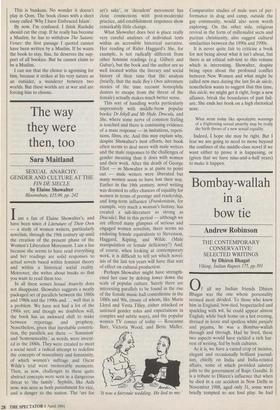The way they were then, too
Sara Maitland
SEXUAL ANARCHY: GENDER AND CULTURE AT THE FIN DE SIECLE by Elaine Showalter Bloomsbury, f15.99, pp. 242 Iam a fan of Elaine Showalter's, and have been since A Literature of Their Own — a study of women writers, particularly novelists, through the 19th century up until the creation of the present phase of the Women's Liberation Movement. I am a fan because she seems to have read everything and her readings are solid responses to actual novels based within feminist theory and within a historical social reality. Moreover, she writes about books so that you want to read them too.
In all these senses Sexual Anarchy does not disappoint. Showalter suggests a neatly packaged set of parallels between the 1880s and 1980s and the 1990s and. . . well that is a problem. We have not had a lot of the 1990s yet; and though we doubtless will, the book has an awkward shift to make between reportage and prophesy. Nonetheless, given that inevitable constric- tion, the parallels are there — 'feminism' and 'homosexuality,' as words, were invent- ed in the 1880s. They were created to meet a social need: a radical attempt to redefine the concepts of masculinity and femininity, of which women's suffrage and Oscar Wilde's trial were memorable moments. Then, as now, challenges to these quite abstract concepts were seen as a dangerous threat to 'the family'. Syphilis, like Aids now, was seen as both punishment for vice, and a danger to the nation. The 'art for art's sake', or 'decadent' movement has close connections with post-modernist practice, and establishment responses show remarkably little change.
What Showalter does best is place really very careful analyses of individual texts within an accessible historical narrative. Her reading of Rider Haggard's She, for example, is not radically different from other feminist readings (e.g. Gilbert and Gubar), but the book and the author are so well located within the literary and social history of their time that the analysis (briefly, that the male Boy's Own adventure stories of the time recount homophile desires to escape from the threat of the female) actually makes much better sense.
This sort of handling works particularly impressively with middle-brow popular books: Dr Jekyll and Mr Hyde, Dracula, and She, where some nerve of common feeling is touched and there is continuing evidence of a mass response — in imitations, repeti- tions, films, etc. And this may explain why, despite Showalter's best efforts, her book often seems to deal more with male writers and the male responses to the challenges of gender meaning than it does with women and their work. After the death of George Eliot — as Showalter is at pains to point out — male writers were liberated but many women seem to have lost their way. Earlier in the 19th century, novel writing was deemed to offer chances of equality for women in terms of prestige and readership, and long-term influence (Frankenstein, for example, very much a woman's fantasy, has created a sub-literature as strong as Dracula). But in this period — although we are offered many glimpses of serious and engaged women novelists, there seems no enduring female equivalents to Stevenson, Haggard, Kipling, and Wilde. (Male manipulation or female deficiency?) And, of course, when looking at contemporary work, it is difficult to tell yet which novel- ists of the last ten years will have that sort of effect on cultural production.
Perhaps Showalter might have strength- ened her case by delving lower down the scale of popular culture. Surely there are interesting parallels to be found in the rise of the female music-hall comedienne in the 1880s and 90s, (many of whom, like Marie Lloyd and Vesta Tilley, either attacked or satirised gender roles and expectations in complex and subtle ways), and the popular women TV comics of today — Roseanne Barr, Victoria Wood, and Bette Midler.
It was a fairytale wedding. He lied to me.' Comparative studies of male uses of per- formance in drag and camp, outside the gay community, would also seem worth exploring. On the other side, religious revival in the form of millenialist sects and puritan christianity, also suggest cultural similarities between the 1890s and 1990s.
It is never quite fair to criticise a book for not being about what it isn't about, but there is an ethical sub-text to this volume which is interesting. Showalter, despite being open about the profound conflict between New Women and what might be called new men during the last fin de siecle, nonetheless wants to suggest that this time, this siecle, we might get it right, forge a new alliance, break the boundaries of past fail- ure. She ends her book on a high rhetorical note: What seem today like apocalyptic warnings of a frightening sexual anarchy may be really the birth throes of a new sexual equality.
Indeed, I hope she may be right. But I fear we are going to need to move beyond the confines of the middle-class novel if we want either to prove it is happening, or (given that we have nine-and-a-half years) to make it happen.


















































 Previous page
Previous page